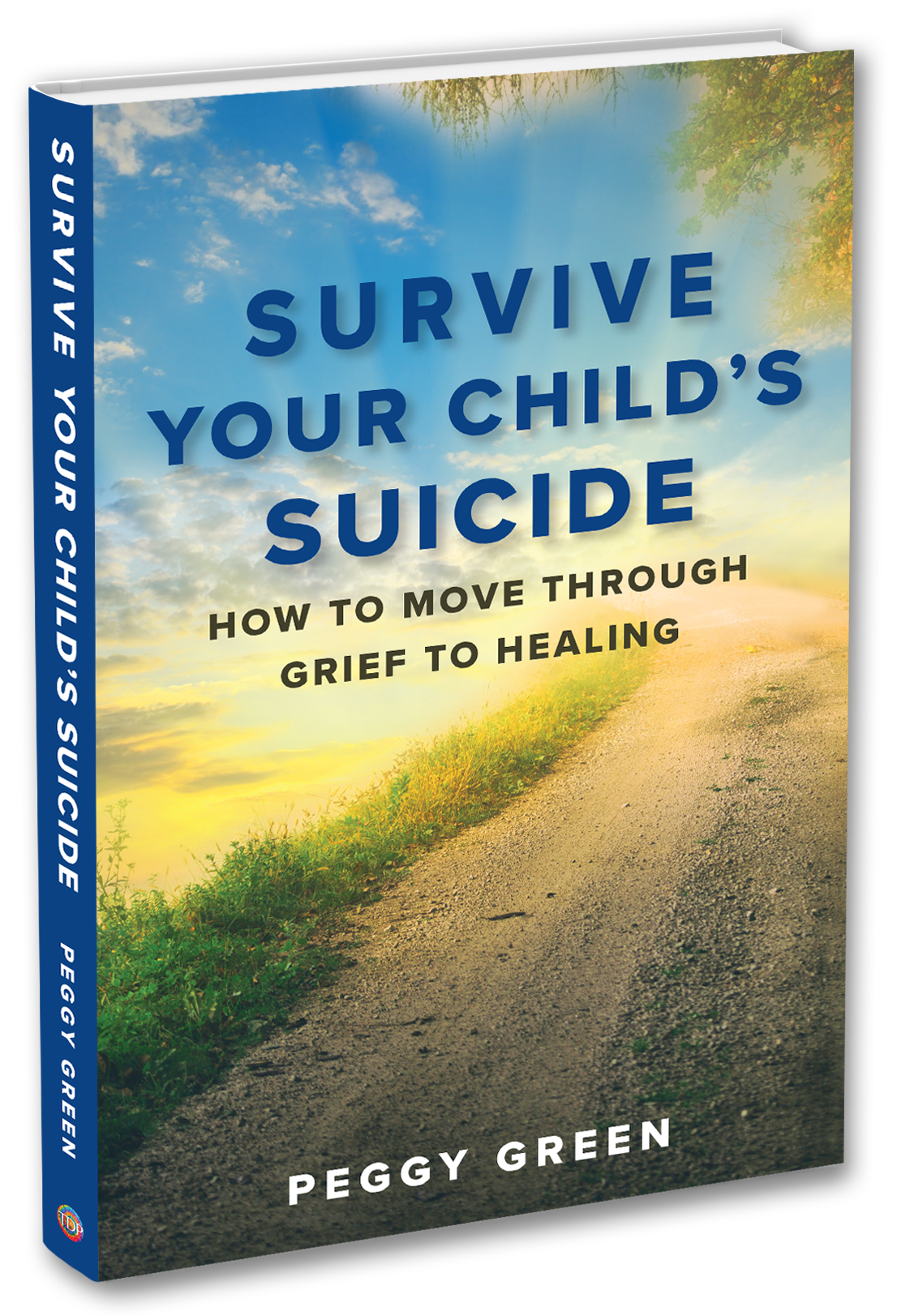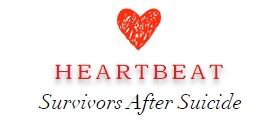Our Books


If you are ready to take the next step in your healing journey, join Peggy as she helps you to recover after the loss of your child.
Survive Your Child's Suicide
How to move through Grief to Healing.
Peggy has survived losing not just one child, but two, including her son by suicide. She knew she must use every tool possible to survive this tragedy. Starting with acceptance – a challenging but necessary first step – she courageously walked her grief journey.
Introducing: Three Phases to Move through Grief to HealingNow as a Grief Coach, Peggy teaches these tools in her proven coaching program to help you move through grief to healing. This wholistic step-by-step process is founded on restoring your physical, mental, emotional, and spiritual health.
You can live a fulfilling and productive lifeIf you are asking why this happened, what you could have done differently, or how you will live without your child, you are not alone. Rest assured, others have travelled this road before you – and survived. Moving through your loss requires a conscious decision to heal. You have a choice. Do it for yourself.
Start here. Start now.
“A must-read for anyone suffering the suicide loss of a child. Peggy gives you the same tools and resources that are responsible for her successfully navigating the suicide of her son.”—FRANK KING, The Mental Health Comedian and TEDx Coach
- Learn the tools to move through your grief
- A step-by-step process to restore your physical, mental, emotional, and spiritual health
- Regain your ability to choose to heal
- Understand the three phases of grief to healing
LIFE AFTER CHILD LOSS
Rebuild your life after child loss and dare to be happy again.
Losing a child is said to be the hardest of all pain. You lose a part of yourself and sometimes it feels as if you'll never really be happy again. The grief can be so strong that it keeps you from living your life and even from really being present for your family. Moving on is one of those impossible things you know you need to do, but as a mother, you wonder if it’s possible. But there is hope. It is possible to move through your grief. You can soften the heartache, establish a new norm, and be alive and present again for your family. Author Peggy Green has been through the loss of a child – not just once, but twice – and in Life after Child Loss, she shares her experience and insight so that you, too, can:
- Go a day without feeling as if your world is upside down
- Find support when you feel alone
- Stop feeling guilty for what happened
- Focus on and enjoy life with your remaining loved ones
- Discover your purpose to move forward
- Ease the grieving process and start living again
If you are ready to take the next step in your healing journey, join Peggy as she helps you to recover after the loss of your child.

10% Of All Book Sales Are Donated to Heartbeat Survivors After Suicide.
Book Reviews

Peggy Green gets right to the point of why she is qualified to write this, of why it is so very hard to come through the experience of losing a child – at any age. Because of her experience and her training, and with help from her son Connor, she has particular insights into how to manage and face the grief that often is overwhelming. Her steps are clear and seem simple enough but there is a depth to her words and actions which will help you take care of yourself so you can help those around you who are also grieving. This guide is filled with options that you can choose to do in any order or at all. Peggy’s direct voice shares the pain of her personal losses, as well as the joy of coming to terms with those losses, in plain caring words. These guidelines are useful for recent loss and I will be sharing this book with a friend who lost her only child to suicide as a young teen several years ago. I believe this will help get her back on the road to joy while remembering and honoring her child. What surprised me was that it is helping me work through my personal struggles, which came flooding back as unresolved, from the guilt of losing one child to an ectopic pregnancy that almost killed me and losing two babes in the space of ten months to second term miscarriages. In reading this you will find a forgiving attitude (you can learn to forgive yourself for your anger and grief and that it’s okay to be happy), an understanding heart (it is okay to cry at odd moments in odd places), and some straightforward steps that have already helped others, including me, rediscover the joy of life. Thank you, Peggy, for sharing this most personal journey so others may find joy and life after losing a child.
If you have lost a child, you need a friend who understands, who has gone through such a loss themselves. Peggy Green is that friend. Her book feels as if she enters your home, sits on your couch, and gives you a hug. She lovingly explains how she made it through the death of two children - a baby girl and a grown son. She gives tips to help you find your support system, how to talk about your child, how journaling and finding your higher power helps, how to deal with holidays and birthdays in your own personal way, suggestions about what to do with your child’s possessions, and how to care for yourself. It is a beautiful book to lead you through your grief journey.
This is such a valuable book Peggy has written, and a work that will be an incredible reference to those that have been forced to try and move through grief-one of life’s most difficult transitions. Peggy has done a masterful job of clearly sharing and laying out all she has gone through as well as supportive ideas and methods she has utilized for coping AND thriving. By reading this book, one will realize that there are many that share the experience of loss, and many that can live with the memories by learning from others. Peggy imparts her knowledge and experience in one place that provides an easy read, while helping the reader feel they are not alone. I know there are many that will find this a priceless resource. Well done, Peggy!
Loss of a loved one is hard at best. Suicide is the most difficult to endure. Ms Green understands this struggle personally and has faced this struggle directly. Her understanding and desire to assist others through this trial is unmatched. All would do well to read her message.
Peggy Green’s book Survive Your Child’s Suicide takes on self-help and grief from a delicate, informative place. Grief coach Peggy Green’s self-help book Survive Your Child’s Suicide is a straightforward and gentle guide to parental grief. Green was inspired by personal losses to become a grief coach, speaker, and author of numerous grief books. She lost two of her four children—a nine-month-old daughter in a daycare accident and a twenty-four-year-old son to suicide—as well as her parents and sister. From those experiences, Green developed a wholistic approach to managing grief, drawing on outside methods. Green writes about three overlapping and intertwining phases of grief: acceptance, overcoming fear, and recovery. Great care is given to providing medical, psychological, and statistical information about grief and suicide. An early chapter examines the ways that grief was once a community event, with death and burial rituals lasting for months; it is now a more isolated and isolating time, Green notes. Another chapter shares ways to understand suicide, approaching it with the journalistic questions of what, who, when, where, how, and why and asserting that, for some parents, knowing the answers to each of these questions is vital to healing. The book asserts that “suicide is not an act of selfishness, weakness, or cowardice.” The bulk of Survive Your Child’s Suicide is spent dissecting the three phases of healing. In the section on acceptance, the focus is on avoidance techniques—drugs, alcohol, and busyness, for example—and how they hinder healing. The book notes on repeat that the acceptance phase is not about forgetting the child who died by suicide; it’s more about realizing a new version of life without them in it. The section on the third phase contains the most practical advice, with chapters focusing on physical, mental, emotional, and spiritual health. And the book’s conclusion includes action steps for grieving, while its appendices contain helpful resources like suicide risk factors and warning signs, frequently asked questions and answers about grief, and grief affirmations. Throughout the book are stories from Green’s friends and clients about how they made use of the guidance she gave them in their moments of grief: she showed one friend how choosing to remember who the lost person was and how they lived, rather than focusing on how they died, could lead to better healing. Another friend needed help with coming back to her old, positive self after her daughter died; she and Green worked together to remember what inspired her and nourished her then. Green’s prose is comforting and conversational, treating this complex subject with empathy. Peggy Green’s book Survive Your Child’s Suicide takes on self-help and grief from a delicate, informative place.



In Survive Your Child’s Suicide: How to Move Through Grief to Healing, Peggy Green taps into her own experiences after her son Connor’s suicide—as well as the grief coaching that she now provides to other parents—to offer guidance. She breaks down her system into three phases: acceptance, overcoming your fear, and recovery, each with sub-components. Throughout, she offers plenty of practical information, including suicide statistics, warning signs, and risk factors; signs of anxiety during the grieving process; symptoms of good and poor mental and emotional health; and so on. The 14 grief affirmations she provides seem especially helpful, including “I have changed as a result of my grief,” where she invites grieving parents to acknowledge the reality of a new normal. Green also offers tips on journaling through your grief, ways to eat and exercise to build up your physical health, and more. Some of these strategies will be familiar to readers, but because they’re offered through the lens of an experienced grieving mother, they seem more powerful. This book would be especially helpful to people who embrace a traditional Christian faith; Green writes that God heals all wounds and that it’s important to surrender yourself to Him. She cites the Bible as the source of wisdom. (Atheists, on the other hand, may not find the same sort of comfort, nor would people who seek to reconnect with their loved ones, post-death; Green has concerns that mediumship is ungodly, even Satanic.) Support groups for grieving parents could use this as a workbook as they discuss the suggestions and their feelings. Additionally, this book contains many suggestions that could help parents who have lost children through other means or those simply grieving the loss of a loved one.